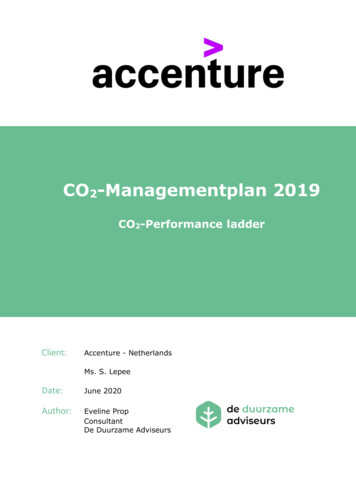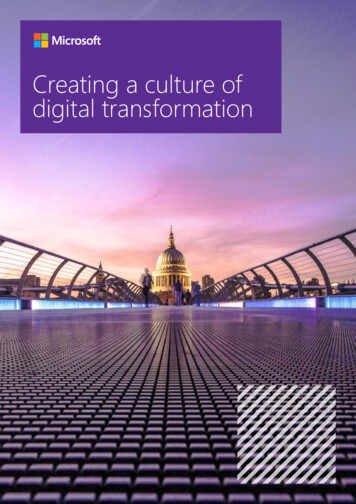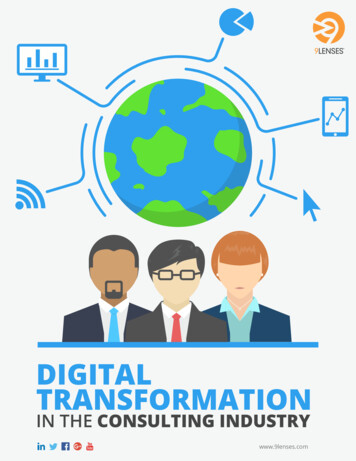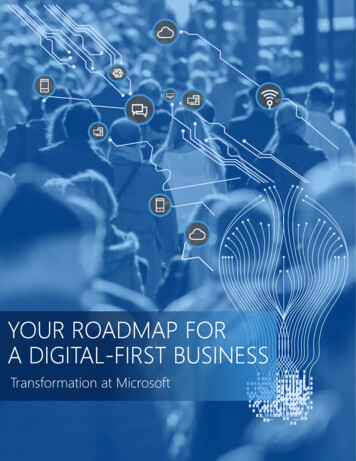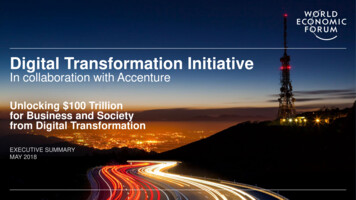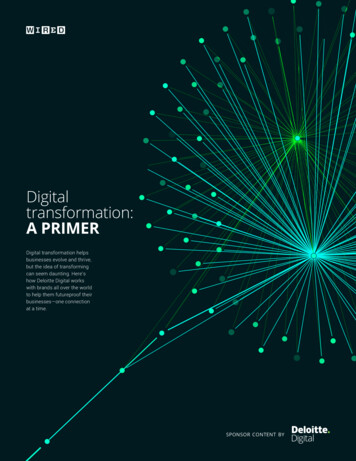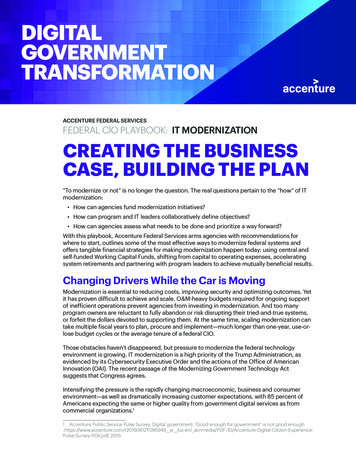
Transcription
DIGITALGOVERNMENTTRANSFORMATIONACCENTURE FEDERAL SERVICESFEDERAL CIO PLAYBOOK: IT MODERNIZATIONCREATING THE BUSINESSCASE, BUILDING THE PLAN“To modernize or not” is no longer the question. The real questions pertain to the “how” of ITmodernization: How can agencies fund modernization initiatives? How can program and IT leaders collaboratively define objectives? How can agencies assess what needs to be done and prioritize a way forward?With this playbook, Accenture Federal Services arms agencies with recommendations forwhere to start, outlines some of the most effective ways to modernize federal systems andoffers tangible financial strategies for making modernization happen today: using central andself-funded Working Capital Funds, shifting from capital to operating expenses, acceleratingsystem retirements and partnering with program leaders to achieve mutually beneficial results.Changing Drivers While the Car is MovingModernization is essential to reducing costs, improving security and optimizing outcomes. Yetit has proven difficult to achieve and scale. O&M-heavy budgets required for ongoing supportof inefficient operations prevent agencies from investing in modernization. And too manyprogram owners are reluctant to fully abandon or risk disrupting their tried-and-true systems,or forfeit the dollars devoted to supporting them. At the same time, scaling modernization cantake multiple fiscal years to plan, procure and implement—much longer than one-year, use-orlose budget cycles or the average tenure of a federal CIO.Those obstacles haven’t disappeared, but pressure to modernize the federal technologyenvironment is growing. IT modernization is a high priority of the Trump Administration, asevidenced by its Cybersecurity Executive Order and the actions of the Office of AmericanInnovation (OAI). The recent passage of the Modernizing Government Technology Actsuggests that Congress agrees.Intensifying the pressure is the rapidly changing macroeconomic, business and consumerenvironment—as well as dramatically increasing customer expectations, with 85 percent ofAmericans expecting the same or higher quality from government digital services as fromcommercial organizations.11 Accenture Public Service Pulse Survey, Digital government: “Good enough for government” is not good enough-https://www.accenture.com/t20160912T095949 w /us-en/ cePulse-Survey-POV.pdf, 2016
As the pace of mission and business operations and service delivery accelerates, moreadaptive and agile systems have become essential. For example, the Pentagon recentlyconcluded that accelerated adoption of cloud computing is “critical to maintaining ourmilitary’s technological advantage.”2 At the same time, agencies face a growing inability tosupport legacy environments thanks not only to retiring workers and skills shortages but alsodeclining vendor support and lack of interoperability with new commercial technologies.Four Funding Strategies for IT ModernizationWhile most CIOs and other IT leaders have long recognized the need to modernize, they haveoften lacked the funding to do so. For example, tight budgets and reliance on ContinuingBudget Resolutions over the past several years have made consistent IT investment decisionschallenging. This makes identifying new sources of funding a priority. CIOs can use acombination of four core financial strategies to make IT modernization a reality.STRATEGY #1 – TAKE ADVANTAGE OF WORKING CAPITAL FUNDSGood choice for modernizing commodity systems and infrastructureThe Modernizing Government Technology Act (MGTA) of 2017 was passed as part of theNational Defense Authorization Act (NDAA) for fiscal year 2018. Signed into law by the TrumpAdministration on December 12, 2017, MGTA creates new funding streams that agenciescan use to modernize their technology to lower the cost of government, improve missionperformance and agility, capture greater efficiencies and enhance security. Among the mostnotable MGTA features are Working Capital Funds (WCF)—multi-year, revolving funds with twospecific varieties: Central WCF. MGTA promotes the use of a centrally administered competitive ITModernization Central Fund. Any federal agency can apply for funding that must berepaid within five years. The proposed overall funding is just under 500 million for fiscalyear 2018-2019. Sunset provisions limit most funding to these time periods—creating anincentive to move quickly to secure the dollars.To capture these funds, agencies need to present a strong business case for ITmodernization projects/initiatives that adopt agile or iterative software development, mustshow preference to the use of commercial cloud technology, enhance cyber security andembrace strong program management and procurement strategies. It will also be criticalto embrace standardized Technology Business Management-based metrics and reportingstructures (an Office of Management and Budget requirement already familiar to thosemanaging certain aspects of agency IT budgets in fiscal year 2018). Self-funded agency WCF. MGTA also authorizes the 24 CFO-level agencies to takeadvantage of their own new or existing self-funded WCFs to support modernization effortswithin those agencies. Due to the needed and immediate flexibility that they offer, selffunded WCFs can have significant long-term impact.Agencies are well advised to focus these investments initially on quick-win projects thatcan deliver rapid payback with meaningful impact and minimal risk. This allows limitedfunding to be used for several modernization cycles within the funding window. Cloud2 Memo, “Accelerating Enterprise Cloud Adoption,” Deputy Secretary of Defense Patrick Shanahan, September 13,20172FEDERAL CIO PLAYBOOK: IT MODERNIZATION
infrastructure and software/platform-as-a-service are prime examples as they minimizeupfront development. Continuing with data-center and contact-center optimization andconsolidation may be wise choices for similar reasons.STRATEGY #2 – SHIFT FROM CAPEX TO OPEXGood choice for modernizing fully integrated or commerciallyfocused systemsAgencies operate many legacy systems on premise using in-house or contractor resources—atsignificant cost for basic operations and support. While modernizing them can help reducemaintenance costs and deliver other performance advantages, the scope of these systemsoften necessitates significant upfront capital investments to upgrade.By shifting some systems from capital expense to operating expense, CIOs can kill multiplebirds with a single stone. Among them: minimizing immediate capital investment, reducingongoing costs (and making them more predictable), tapping into commercial platforms,innovation and expertise, and addressing cybersecurity risks.CIOs can run this play in a variety of ways: Managed services, where existing systems are shifted to third-party management andcan therefore be modernized through operating costs without the constraints of annualbudgets. Shared services, where multiple agencies team up to standardize and simplify core backoffice processes (for example, finance, procurement and human capital management). Software-as-a-Service (SaaS), which makes it possible to benefit very quickly from thelatest technology—with continual enhancements and security updates—without any large,upfront costs.This play is already top of mind for many, as evidenced by a recent Accenture Federal Servicessurvey of 185 federal IT decision-makers.3 When asked about making this shift from capitalexpense to operating expense for cloud-based IT, 80 percent agreed that this switch makes itaffordable to migrate systems that had been too costly to move in the past. What’s more, 80percent also believe that funds freed up by moving to the cloud and other new technologies isor will be financing the migration from legacy systems.As one example, a federal agency recently leveraged a managed services contract tomodernize a suite of mission-critical mainframe-based legacy systems. By reducing O&Mspending under the agreement, the agency could reduce long-term contracting costs whilefacilitating upfront investments in modernization. In addition, the multiyear agreementprovided the flexibility to update the system iteratively. Taking advantage of DevOps toincrease development speed and agility, the agency was able to replace more than 3 millionlines of COBOL code and legacy databases with a new, cloud-ready, Java/Oracle-basedapplication suite. Following the migration of 18 billion records, the systems were seamlesslyswitched on with no end-user impact.3Digital Decoupling Survey, Accenture Federal Services, October 2017ACCENTURE FEDERAL SERVICES3
STRATEGY #3 – ACCELERATE SYSTEM RETIREMENTSGood choice for replacing agency-specific systems, applications andenvironmentsFor some systems, the most sensible path forward is to simply retire them. A thorough portfolioanalysis (see GIVE ENTEPRISE SYSTEMS A CHECKUP – next section) can determine whichsystems are aligned with current and future business needs or are candidates for retirement.By eliminating redundant or underused systems, CIOs can demonstrate rapid progresson multiple fronts: reducing costs and vulnerabilities, increasing efficiency and freeing upresources for other modernization initiatives.In some cases, the application itself is managed by a specific program while the support andinfrastructure costs are borne by IT. Many CIOs are familiar with the frustration of having tomaintain legacy technology to power outdated applications, which drive up costs and risksagency-wide. This scenario can create a disincentive to modernize where the costs andbenefits are not distributed equitably. A detailed business case showing total and ongoingcosts for orphan systems can provide additional motivation for programs to modernize—orserve to justify higher chargeback fees for those that elect not to.In terms of migrating systems to the cloud, the conventional wisdom is that they should berearchitected first to fully capitalize on native cloud capabilities. However, in some cases, amore accelerated “lift and shift” approach is preferable. Using this model, agencies can retirelegacy infrastructure faster and then invest the cost savings in subsequent cloud optimization.For evidence that this approach can pay off, look to the Federal Communications Commission,where former CIO David Bray was able to slash spending while delivering better performance.When Bray took over as CIO of FCC in 2013, he uncovered 207 systems—some dating backmore than 20 years. Those systems were being maintained by nearly 400 contractors whosetenure averaged 15 years. All told, the agency was devoting 85 percent of a 64 million ITbudget to legacy systems. Within four years, FCC had cut legacy spend by 35 percent througha modernization plan focused on delivering small wins, migrating to cloud computing andtrimming back contracted personnel.In terms of shifting from CapEx to OpEx, FCC replaced its aging Consumer Complaint Centerwith a commercial SaaS solution. The SaaS option cost just 450,000 and was deployed inonly six months—a fraction of the 3.2 million and two-year timeframe quoted to build a newsystem internally. The agency also deployed a cloud-based Electronic Comment Filing Systemwithout requiring new money from Congress. Those initial successes prompted the agency togo “all in” on cloud with “Operation Server Lift.” Moving racks of servers to facilities run by acommercial cloud provider has led to an immediate decline in legacy spend.4STRATEGY #4 – PARTNER TO CAPTURE & SHARE PROGRAMCOST SAVINGSGood choice for modernizing large, agency-specific systemsInvestments in modernization can produce cost savings far beyond the IT budget itself. Thechallenge for many agencies is capturing and recognizing these benefits, especially as theycan often dwarf IT savings -it/136268/FEDERAL CIO PLAYBOOK: IT MODERNIZATION
With this play, the CIO engages with program leaders to build a joint business case to justify amodernization investment based on total financial impact. For example, collaboration betweenthe CIO and program leaders can reveal significant opportunities to redesign and improvebusiness processes, including adopting automation. The growing maturity of digital platformsmakes it easier to jointly develop prototypes to demonstrate and validate these proposedperformance improvements.Ultimately, better processes and more up-to-date systems can yield reductions in cost toserve, fraud, waste & abuse, supply chain and other program costs—funds that can thenbe reallocated to further modernization efforts by both IT and the programs it supports.Furthermore, initial successes can make it easier to work with other programs on win/winpartnerships to improve performance and reduce costs.Four Steps to IT ModernizationWith sources of funding identified, agencies can begin the actual planning for ITmodernization. Historically, IT modernization efforts have focused too often on the largest ormost immediate “dumpster fire” at the expense of plotting a more thoughtful path forward.While a sense of urgency is important, too much haste can lead agencies to simply replicatepast mistakes in new form factors and to miss out on potential synergies.Any IT modernization strategy that creates a clear, actionable path forward needs to addressfour key elements: Create a baseline. To ensure a level playing field for decision making, start with acomprehensive and unbiased understanding of the health and performance of youragency’s existing application portfolio. Define a mission-driven strategy. Base the go-forward strategy on needed andanticipated business outcomes and requirements, which will drive prioritization andfunding. Build the roadmap. Consolidate disparate business cases into an integrated andactionable plan for both individual systems and broader portfolios. Organize for success. When it comes to long-term, sustainable success, how youexecute is as important as what you build.ACCENTURE FEDERAL SERVICES5
GIVE ENTERPRISE SYSTEMS A CHECK-UPAgency CIOs usually inherit environments that are large, complex and often opaque. Itcan be challenging to get a handle on exactly what exists—much less which systems aremodernization priorities.Application Portfolio Management (APM) provides benchmarking and analysis of the currentstate. Beyond evaluating the health and performance of the existing portfolio, APM can helpreveal interdependencies in systems, including “shadow IT” and other program-maintainedapplications. Ultimately, these insights enable CIOs to decide which systems to maintain andwhich to retire, replace or modernize.An effective APM program delivers the information CIOs need to make long-term decisions,including: Strategic alignment to ascertain the fundamental role an application plays in theorganization, including measurable impact, traceability to mission or businessobjectives and how its failure would affect operations. Cost to operate to establish both direct and indirect maintenance costs, includingfinancial impact of retirement on other operations. Functional health to identify direct impacts on user performance, includingsatisfaction, constraints, functional gaps and redundancies. Technical health to determine compliance with current enterprise architecturestandards, ability to consistently meet performance objectives and service-levelagreements, availability of vendor or other support, and anticipated end of life. Security vulnerability to create a risk profile encompassing known securityvulnerabilities and exploitable architectural patterns, adherence with current securitystandards, integration with existing cybersecurity networks and state of cyberhygiene. Modernization and cloud readiness to understand how performance, technical andregulatory and compliance requirements impact the viability and cost of potentialremediation, replacement or migration strategies.Leading with APM is valuable for two reasons. First, it provides the more completeunderstanding of current strategies, drivers, commitments and liabilities needed for moreeffective planning. Second, it creates talking points for subsequent costs-versus-valuediscussions with the business.While some of this knowledge is nominally maintained today, the actual data is too oftenincomplete and outdated. What’s needed are more agile and uninterrupted approaches thatcan be used to dynamically answer “what if” questions and drive a continuous optimizationstrategy. These assessments should also consider the implications of in-flight projects to aidlong-term planning.6FEDERAL CIO PLAYBOOK: IT MODERNIZATION
DO YOU NEED A TARGET DIGITAL ARCHITECTURE &OPERATING MODEL?Yes, there is urgency for every agency to modernize. But what exactly is the agencymodernizing to?Simply replacing or refreshing existing legacy systems is akin to paving cow paths. Instead,invest time and thought into what the agency’s future can and should look like. What are themission goals that could be pursued via redesigned processes and modernized systems? Whatdo today’s (and tomorrow’s) customers need and want? Is there an opportunity to join forcesand share services with other organizations?Consider not just modernizing applications but digitizing the agency. Start by creating adetailed definition of the future state—including technology architecture, operating model andperformance objectives. That vision will help ensure that an agency doesn’t waste preciousdollars or time modernizing a soon-to-be-obsolete system. Rather, it prioritizes modernizationefforts that will support longer-term, strategic and business outcome goals while stilladdressing more immediate cost, risk and compliance concerns.LEAD WITH MISSION REQUIREMENTSEnterprise IT systems and applications do not operate in a vacuum. In fact, they are closely tiedto the business operations, services and processes they support, and they move in concertwith each other. Consequently, a proposed modernization strategy must earn the full backingof the business—and that requires the CIO to ensure that anticipated mission or businessbenefits justify the mission or business investment.In terms of senior decision-makers, aim to engage them early to understand overall agencyobjectives and priorities. Seize the opportunity to educate them on the strategic goals of themodernization program—typically improved agility, more actionable insight and lower totalcost of ownership—as well as nearterm cost-savingopportunities.Review and get theirLooking for quick-win candidates that can indeed be “quick”? Look forinput on known hotmodernization opportunities driven by one or more of the following:topics and potentialquick wins (see Need identified by key decision maker or executiveMODERNIZATION: Addresses a common government problem with potential to jointlyHOT LIST).pursue (citizen engagement, case management or use authorization)Also discuss GAO or IG finding, or Congressional concernhow emerging Known technical performance issuetechnologies likethe cloud, artificial FISMA issueintelligence (AI) and High-impact, measurable business process improvement opportunitythe Internet of Things Multiple data redundancy/re-keying issues or high administrative(IoT) can deliverburden issuetransformative Systems with sensitive data and potential security concernsperformanceimprovements. Large frustrated user communityMODERNIZATION: HOT LISTACCENTURE FEDERAL SERVICES7
Why are clear business objectives so critical? Quite simply, without them many projects fail todeliver anticipated benefits. Use your APM data to engage program executives in collaborativediscussions about current constraints and future objectives. Strive to create a joint strategyfor simultaneously modernizing business processes and systems. All the while, keep the focuson simplification, consolidation and standardization where possible. As part of this exercise,introduce business stakeholders to approaches likes human-centered design (HCD) or servicedesign as frameworks for integrating user requirements consistently across the end-to-endcustomer journey.For each proposed project, clearly define performance objectives and create a business casejustifying required investments based on realizing these anticipated outcomes. Don’t limityourself to financial metrics—but do ensure that you establish tests and measures for assessingsuccess. If you find that your objective is not measurable, consider other ways to determinewhether you are hitting your targets. These metrics can also serve as mileposts for iterativedevelopment with project sequencing driven by anticipated impact.CONSIDER ALL OF THE OPTIONSWith stakeholder input and buy-in for both individual requirements and overall priorities,CIOs can transform application gap analysis into actionable modernization roadmaps. Forspecific systems, modernization can take many shapes financially and technically. Key factorsto consider include the uniqueness of the function performed (in other words, is there acommercial equivalent?), as well as long-term strategic and operational plans. Among the mostcommon options: Rearchitecting/Remediating/Refactoring – reengineering legacy systems to delivermore modern performance and interoperability; these efforts can be narrowly scopedor designed to fully replace all legacy code and dependencies. More agile approachesdriven by automation are making this strategy faster to implement and more costeffective than was previously possible. Replatforming – “lifting and shifting” systems from high-cost hardware to more cloudready platforms using commoditized technology. Replacing – deploying an entirely new COTS, SaaS or custom application to replacea legacy system; digital platforms (PaaS) can provide a compelling hybrid solutionaddressing agency-specific requirements as a service. Retiring – decommissioning an application that has become redundant, has lost itsuser base or has become so outdated that it no longer has value to the agency.In the case of monolithic legacy systems, a hybrid strategy to digital decoupling is oftenrequired. Critical capabilities can be layered in near term while working to unlock core businessdata, logic and rules for use in new applications. For risk mitigation, application discovery canidentify and map current “black box” functionality so it can be more readily exploited andexported.In deciding which specific systems to modernize and when, consider both potential impactor benefits, such as cost savings, improved performance and better cyber hygiene, againstthe project’s complexity, which drives cost, time requirements and risk. A potential danger isfocusing on retirement alone because it will drive agencies to primarily target smaller systemsthat are neither strategic to the mission nor likely to generate significant cost savings.Instead, pursue a two-track strategy with an overriding focus on advancing the mission withmore agile, transformative capabilities while lowering long-term sustainment and operational8FEDERAL CIO PLAYBOOK: IT MODERNIZATION
costs. As a secondary focus, charter a dedicated team to pursue quick-win opportunities thatdeliver rapid return on investment (ROI) by rationalizing and retiring redundant systems. Thistwo-track approach makes it possible to pursue and provision each objective appropriately—ensuring that tactical cost savings don’t come at the expense of more strategic objectives.As one option, agencies can prioritize based on potential impact and time to payback (seefigure below).MODERNIZATION PRIORITIZATION MATRIX These projects should be toppriorities. Beyond their directimpact, they can help createmomentum for the overall program. Replacing legacy systems withCOTS, SaaS/PaaS or Shared Servicesis a frequent focus. Rapid ROI can make this acompelling target for time-boxedWorking Capital Funds. Good opportunity to testmodernization strategies &processes. These are often large, complexbusiness process reengineeringprojects of strategic importance andlarge potential payoff; however, theyalso require significant commitmentand expertise due to their risk. Low priority projects to avoid wherepossible. Infrastructure modernizationmay fall here due to the modestdifferentiation it delivers; cloudmigration may be a better strategy.For security vulnerabilities, distinguish between systemic challenges that can only be mitigatedby active modernization and more immediate needs that can be remediated with better cyberhygiene. For vulnerabilities requiring modernization, the impact is often strategic.ORGANIZE FOR SUCCESSThe best-laid plans mean little without great execution. Creating dedicated teams and centersof excellence for core aspects of IT modernization can scale and industrialize efforts and takeadvantage of economies of scale. For example, digital service centers can bring togetherscarce talent to create reusable, citizen-centric apps that can accelerate end-to-end digitaltransformation using common platforms.IT modernization projects have a justified reputation for risk and failure. The truth is that legacysystems entail many unknowns that can be answered only through active discovery. As a result,adoption of agile and other iterative approaches is critical to managing risk—especially asorganizations look to migrate static implementations to very dynamic cloud environments.ACCENTURE FEDERAL SERVICES9
While the need for agile-based approaches like DevSecOps is clear, it is also important torecognize that project pace isn’t one size fits all. Rather, systems of record (ERP), engagement(CRM or SCM) and innovation have differing requirements—user expectations, as well asadaptability of related processes, workforces and ecosystems—that are most effectivelyundertaken at different speeds.Finally, strong governance with active participation of business stakeholders is criticalto keeping programs moving forward and aligned with mission objectives. Workingcollaboratively to define success metrics and proactively reporting on them builds trust andengagement with key stakeholders.The Time is NowThere is no dispute that federal agencies need to modernize the core systems powering theiroperations with greater urgency. Rather, the real question is how they do so in a thoughtful,deliberate, user-centric way—positioning them for continued success with digital platformsand operating modes that are more agile, secure, intelligent and cost-effective to operate.The additional funding available under MGTA creates the impetus to move forward today andmake this a reality. However, agencies should not limit themselves to WCFs but also exploremultiple avenues that can support end-to-end transformation.10FEDERAL CIO PLAYBOOK: IT MODERNIZATION
AUTHORABOUT ACCENTURE FEDERAL SERVICESADDITIONALCONTRIBUTORSVisit us at www.accenture.com/federalDavid McClure, Ph.D.Principal Director,Federal CIO Advisory ServicesAccenture Federal Servicesdavid.mcclure@accenturefederal.comJohn ConleyKathy ConradMalcolm JacksonJohn LowAndy McCallumRowan Miranda, Ph.D.Scott QuehlEric StogoskiCraig WrightAccenture Federal Services, a wholly owned subsidiary ofAccenture LLP, is a U.S. company with offices in Arlington,Virginia. Accenture’s federal business has served every cabinetlevel department and 30 of the largest federal organizations.Accenture Federal Services transforms bold ideas intobreakthrough outcomes for clients at defense, intelligence, publicsafety, civilian and military health organizations.Follow us @AccentureFed on TwitterYou can also follow us on LinkedInABOUT ACCENTUREAccenture is a leading global professional services company,providing a broad range of services and solutions in strategy,consulting, digital, technology and operations. Combiningunmatched experience and specialized skills across more than40 industries and all business functions—underpinned bythe world’s largest delivery network—Accenture works at theintersection of business and technology to help clients improvetheir performance and create sustainable value for theirstakeholders. With more than 435,000 people serving clients inmore than 120 countries, Accenture drives innovation to improvethe way the world works and lives.Visit us at www.accenture.com.Copyright 2018Accenture Federal ServicesAll rights reserved.Accenture and the Accenture logoare trademarks of Accenture.
FEDERAL CIO PLAYBOOK: IT MODERNIZATION CREATING THE BUSINESS CASE, BUILDING THE PLAN ACCENTURE FEDERAL SERVICES DIGITAL GOVERNMENT TRANSFORMATION. 2 FEDERA CI PAYBOOK: IT MDERNIATIN As the pace of mission and b
